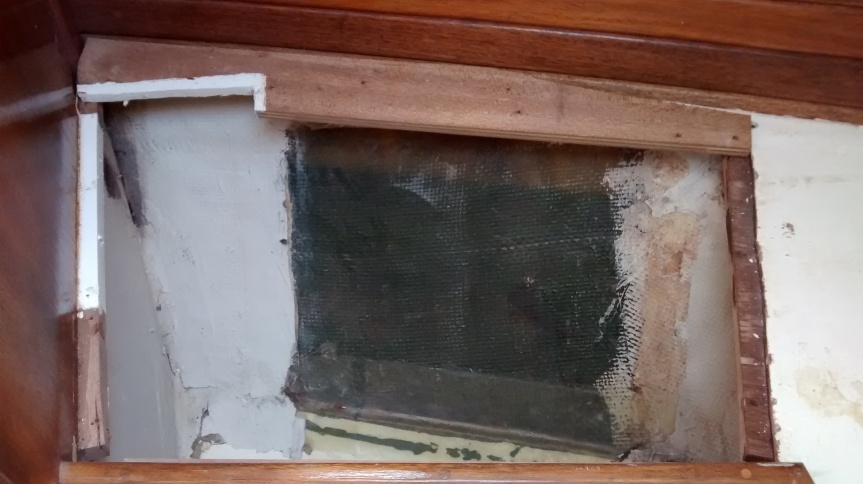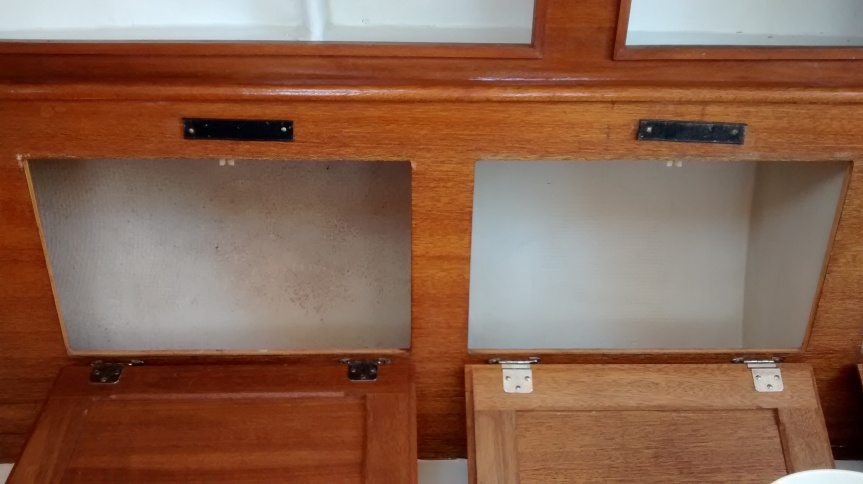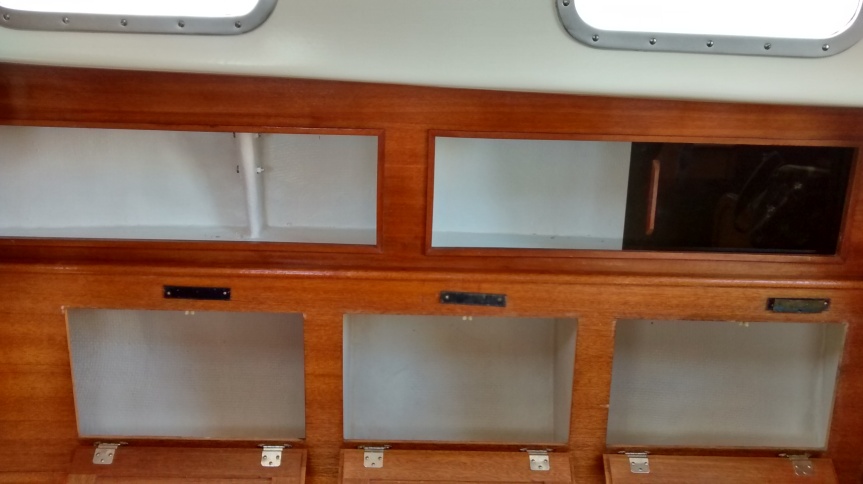We headed down to the boat with great anticipation last weekend, hoping that the smell would be, if not completely gone, then very much improved. As we climbed the ladder to the cockpit, I was disappointed that I couldn’t tell a difference. But when we opened her up and went inside, it was actually A LOT better! Hmmm. What was up with the cockpit? I walked outside again and took a look around. Wait a minute. The blue dodger? I stuck my nose on it and sniffed. Yep! That was it. It must have been stored inside the boat during the offseason. I unzipped and unsnapped everything, pulled it off, and tossed it over the side. Success! As for the dodger, looks like we have yet another thing to wash before it comes back on board. Buoyed by our success, we got down to work.
Jeff had been very busy at work all week and also worked a half-day of overtime on Saturday so our goals for the weekend were modest. Get rid of the holding tank, smooth any resulting rough edges, and try to remove the fifth seacock. These were basically one-man jobs, so I would continue to clean and empty the boat in between handing Jeff tools and cheering him on.
First up was to remove the holding tank. Since the tank was located under the port side of the v-berth, we initially thought we were going to have to cut out that portion of the v-berth. It’s amazing how much more comfortable we’ve become with boat work. Back with Little Bristol, we were very hesitant to make any big changes. Now three years into boat ownership, we were saying, “Oh, we’ll just dismantle the v-berth!” Fortunately our mooring neighbor at Shenny, Vincent, had come over for a tour the previous weekend. When we told him our plans he said that there were probably screws holding it together. Sure enough, a closer inspection revealed screws and a seam, all of which had been painted over 38 years ago so they weren’t exactly easy to see at first glance. Well this would be much easier than cutting everything out. Thanks, Vincent!
As with everything boat related, the simple act of removing a dozen screws took well over an hour given that they were covered with paint which needed to be dug out before we could access the slot on the head of the screw. Finally it was done, and after a lot of pulling and brute force, Jeff was able to lift out the wood which provided great access to the holding tank. Two edges of the tank had been fiberglassed onto the hull, so after putting on his gear (Tyvek suit with hood, gloves, and respirator), Jeff busted out his trusty Dremel. It wasn’t too long after that before the holding tank was out. Hooray!

It’s hard to tell the depth from the picture, but we’ve just gained a ton of extra space. After all, a twenty-gallon tank was in there. That’s a lot of volume. As of now we’re thinking that it will be a great spot to put the sewing machine and related supplies, if we end up bringing one with us for canvas and sail repairs. It would also make a very good booze locker!
On Sunday we were back at the boat to smooth out the rough edges where the tank had been, and to do battle with the seacock. Jeff had already cut out the thruhull the previous weekend, but instead of popping out like the other four, this seacock remained firmly attached to the hull. Even hammering it hadn’t helped. It was an after-market seacock which we were suspecting had been installed with 3M’s 5200, a VERY tenacious sealant which is also known in some circles as the Devil’s Glue. We posted online on Sailnet and Cruisers Forum, looking for solutions that didn’t involve the use of C-4 (although we were willing to try it).
We ended up making a Defender run and buying North Star’s Un-hesive, a spray specifically designed to remove 5200. Jeff scored the area, sprayed in some Un-hesive, then waited. After a few minutes he was able to wedge the tip of a screwdriver in the area, so he sprayed some more. Finally after a lot of spray, a lot of hammering, and a lot of prying, it came out. Success! After all of that it was pretty easy for him to put on the fiberglass gear, bring out the Dremel, and smooth out where the holding tank had been fiberglassed to the hull.
While Jeff was busy hammering and prying, I was scrubbing away. Due to the prior owner’s health issues, Pegu Club had been on the hard for a year and a half before being splashed again this summer. Mildew had taken hold in the lockers (along with general grime), and she needed a good scrub.
One of the things we love about the Bristol 29.9 is all of the storage that it has. We’ve read that it has more storage than many boats that are larger. Of course all of that storage makes for a lot of areas to clean. I still have a long way to go, but it’s amazing what quick work can be done with a scrub brush, a bucket of water, and some Clorox Cleanup.
The shadows don’t do the “before” shot justice, but here’s a before and after shot:
By the time we left, this is what we had:
As Jeff said when he looked at the finished product, “Now I can actually imagine keeping food in there!”
All in all it was a very successful weekend. The smell was gone, we had gained a ton of extra storage from the removal of the holding tank, the seacock had been vanquished, and Pegu Club was starting to breathe a sigh of relief as she slowly became clean again.



Great work, both of you. The photos helped us to visualize all of your hard work.
LikeLike
Thanks, Dad. There’s a long way to go, but bit by bit we’ll get there.
LikeLike